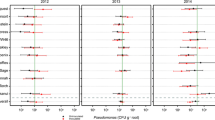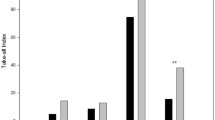Abstract
Gaeumannomyces graminis var. tritici (Ggt) soil DNA inoculum levels in wheat fields were studied in NewZealand as part of work to identify wheat fields with a low risk of take-all. Ggt DNAinoculum levels have been identified overseas as peaking near the harvest date of wheat then declining. Early sowing is also reported to increase take-all infection. The changes in Ggt inoculum levels that occur during the post-harvest period in New Zealand and the implications were for the risk of severe take-all were unknown. Ggt DNA inoculum levels were monitored over the pre- and post-harvest period from February to July in 12 commercial wheat fields. For 10 second wheat fields, mean post-harvest inoculum levels peaked in March at 378 pg Ggt DNA/g soil. Mean inoculum levels then declined at each subsequent sample to the final sample in July when levels were less than one-third (103 pg Ggt DNA/g soil) of those in March. Linear regression was used to quantify the level of decline- from 1 March to 1 July predicted Ggt DNA levels declined by 78%. In two second wheat fields, post-harvest Ggt inoculum levels were also evaluated using an infectivity bioassay method. The bioassay results supported the declining Ggt inoculum levels observed using the Ggt DNA method. An implication of the results was that early sown consecutive wheat will be challenged by higher Ggt inoculum levels than late sown consecutive wheat.
Similar content being viewed by others
References
Bailey DJ, Gilligan CA (1999) Dynamics of primary and secondary infection in take-all epidemics. Phytopathology 89, 84–91. doi: 10.1094/ PHYTO.1999.89.1.84
Bateman GL, Hornby D (1995) Take-all of cereals: challenges of field experimentation on a patch-forming disease caused by a soil-borne pathogen. In ‘Field experiment techniques, 11–13 December, 1995, Churchill College, Cambridge, UK.’ pp. 31–38.
Bateman GL, Gutteridge RJ, Jenkyn JF (2004) Take-all and grain yields in sequences of winter wheat crops testing fluquinconazole seed treatment applied in different combinations of years. The Annals of Applied Biology 145, 317–330. doi: 10.1111/j.1744-7348.2004.tb00389.x
Bithell SL, Cromey MG, McKay A (2005) Take-all prediction in second wheat crops. In ‘Proceedings of the 15th Australasian Plant Pathology Conference. 15th biennial Australasian Plant Pathology conference handbook’. Geelong, Victoria, Australia. (Ed. D Cahill) p. 205. (Australasian Plant Pathology Society)
Colbach N, Lucas P, Meynard JM (1997) Influence of crop management on take-all development and disease cycles on winter wheat. Phytopathology 87, 26–32. doi: 10.1094/PHYTO.1997.87.1.26
Cotterill PJ, Sivasithamparam K (1987) Take-all inoculum: its occurrence and distribution within a wheat crop and a fallow. Soil Biology& Biochemistry 19, 221–222. doi: 10.1016/0038-0717(87)90086-1
Cotterill PJ, Sivasithamparam K (1988a) The effect of tillage practices on distribution, size, infectivity and propagule number of the take-all fungus (Gaeumannomyces graminis var. tritici). Soil & Tillage Research 11, 183–195. doi: 10.1016/0167-1987(88)90025-6
Cotterill PJ, Sivasithamparam K (1988b) Inoculum of the take-all fungus in rotations of wheat and pasture: relationships to disease and yield of wheat. Transactions of the British Mycological Society 91, 63–72.
Cotterill PJ, Sivasithamparam K (1988c) Survival of the take-all fungus in the presence and absence of susceptible grasses. Australian Journal of Soil Research 26, 313–322. doi: 10.1071/SR9880313
Cotterill PJ, Sivasithamparam K (1989) Inoculum of the take-all fungus (Gaeumannomyces graminis var. tritici) in a mediterranean-type climate: spatial distribution at a field site in Western Australia. Phytophylactica 21, 45–48.
Cromey MG, Parkes RA, Fraser PM (2006) Factors associated with stem base and root diseases of New Zealand wheat and barley crops. Australasian Plant Pathology 35, 391–400. doi: 10.1071/AP06032
Danielson RE, Sutherland PL (1986) Porosity. In ‘Methods of Soil Analysis. Part 1, Physical and Mineralogical Methods’. (Ed. A Clute) pp. 443–461. (Soil Science Society of America: Wisconsin, U.S.A.)
Gosme M, Willocquet L, Lucas P (2007) Size, shape and intensity of aggregation of take-all disease during natural epidemics in second wheat crops. Plant Pathology 56, 87–96. doi: 10.1111/j.1365-3059.2006.01503.x
Gutteridge RJ, Hornby D (2003) Effects of sowing date and volunteers on the infectivity of soil infested with Gaeumannomyces graminis var. tritici and on take-all disease in successive crops of winter wheat. The Annals of Applied Biology 143, 275–282. doi: 10.1111/j.1744-7348.2003.tb00295.x
Heap JW, McKay AC (2004) Spatial distribution of soil-borne disease inoculum DNA in cereal crops and implications for soil sampling protocols. In ‘Proceedings of the third Australasian soilborne diseases symposium. Adelaide, South Australia’. (Eds K Ophel-Keller, B Hall) p. 106. (Department of Primary Industries and Resources South Australia, Adelaide)
Herdina, Roget DK (2000) Prediction of take-all disease risk in field soils using a rapid and quantitativeDNAsoil assay. Plant and Soil 227, 87–98. doi: 10.1023/A:1026566711399
Hornby D (1975) Inoculum of the take-all fungus: nature, measurement, distribution and survival. EPPO Bulletin 5, 320–333. doi: 10.1111/j.1365-2338.1975.tb02483.x
Hornby D (1979) Take-all decline: A theorist’s paradise. In ‘Soil-borne plant pathogens’. (Eds B Schippers, W Gams) pp. 133–156. (Academic Press: London)
Hornby D (1981) Inoculum. In ‘Biology and control of take-all’. (Eds MJC Asher, PJ Shipton) pp. 271–293. (Academic Press Inc. (London) Ltd: London)
Jamieson PD, Porter JR, Wilson DR (1991) A test of the computer simulation model ARCWHEAT1 on wheat crops grown in New Zealand. Field Crops Research 27, 337–350. doi: 10.1016/0378-4290(91)90040-3
Jamieson PD, Martin RJ, Francis GS (1995) Drought influences on grain-yield of barley, wheat, and maize. New Zealand Journal of Crop and Horticultural Science 23, 55–66.
Lebreton L, Lucas P, Dugas F, Guillerm AY, Schoeny A, Sarniguet A (2004) Changes in population structure of the soilborne fungus Gaeumannomyces graminis var. tritici during continuous wheat cropping. Environmental Microbiology 6, 1174–1185. doi: 10.1111/j. 1462-2920.2004.00637.x
MacNish GC (1973) Survival of Gaeumannomyces graminis var. tritici in field soil stored in controlled environments. Australian Journal of Biological Sciences 26, 1319–1325.
MacNish GC, Dodman RL (1973) Survival of Gaeumannomyces graminis var. tritici in the field. Australian Journal of Biological Sciences 26, 1309–1317.
Murray GM, Heenan DP, Taylor AC (1991) The effect of rainfall and crop management on take-all and eyespot of wheat in the field. Australian Journal of Experimental Agriculture 31, 645–651. doi: 10.1071/EA9910645
Ophel-Keller K, McKay A, Hartley D, Herdina, Curran J (2008) Development of a routine DNA-based testing service for soilborne diseases in Australia. Australasian Plant Pathology 37, 243–253.
Quemada M (2004) Predicting crop residue decomposition using moisture adjusted time scales. Nutrient Cycling in Agroecosystems 70, 283–291. doi: 10.1007/s10705-004-0531-5
Roget DK, Rovira AD (1991) The relationship between incidence of infection by the take-all fungus (Gaemannomyces graminis var. tritici), rainfall and yield of wheat in south Australia. Australian Journal of Experimental Agriculture 31, 509–513. doi: 10.1071/EA9910509
Scott PR (1981) Variation in host susceptibility. In ‘Biology and control of take-all’. (Eds MJC Asher, PJ Shipton) pp. 219–236. (Academic Press Inc. (London) Ltd: London)
Scott PR, Hollins TW (1984) Take-all. In ‘Annual Report of the Plant Breeding Institute 1984’. pp. 98–99.
Shipton PJ (1981) Saprophytic survival between susceptible crops. In ‘Biology and control of take-all’. (Eds MJC Asher, PJ Shipton) pp. 295–316. (cademic Press Inc. (London) Ltd: London)
Simon A, Sivasithamparam K, MacNish GC (1988) Effect of application to soil of nitrogenous fertilizers and lime on biological suppression of Gaeumannomyces graminis var. tritici. Transactions of the British Mycological Society 91, 287–294.
Slope DB, Gutteridge RJ, Henden DR (1977) Epidemiology of take-all. Report Rothamsted Research Station Pt. 1, 261–262.
Taylor AC (1966) Wheat crop surveys in Southern NSW. 3. The incidence of take-all. Australian Journal of Experimental Agriculture and Animal Husbandry 6, 242–249. doi: 10.1071/EA9660242
Werker AR, Gilligan CA (1990) Analysis of the effects of selected agronomic factors on the dynamics of the take-all disease of wheat in field plots. Plant Pathology 39, 161–177. doi: 10.1111/j.1365-3059.1990.tb02487.x
Werker AR, Gilligan CA, Hornby D (1991) Analysis of disease-progress curves for take-all in consecutive crops of winter wheat. Plant Pathology 40, 8–24. doi: 10.1111/j.1365-3059.1991.tb02288.x
Wilkinson HT, Cook RJ, Alldredge JR (1985) Relation of inoculum size and concentration to infection of wheat roots by Gaeumannomyces graminis var. tritici. Phytopathology 75, 98–103. doi: 10.1094/Phyto-75-98
Willocquet L, Lebreton L, Sarniguet A, Lucas P (2008) Quantification of within-season focal spread of wheat take-all in relation to pathogen genotype and host spatial distribution. Plant Pathology 57, 906–915. doi: 10.1111/j.1365-3059.2008.01834.x
Wong PTW (1984) Saprophytic survival of Gaeumannomyces graminis and Phialophora spp. at various temperature-moisture regimes. The Annals of Applied Biology 105, 455–461. doi: 10.1111/j.1744-7348.1984.tb03071.x
Wong PTW, Dowling PM, Tesoriero LA, Nicol HI (1993) Influence of preseason weed management and in-crop treatments on two successive wheat crops. 2. Take-all severity and incidence of Rhizoctonia root rot. Australian Journal of Experimental Agriculture 33, 173–177. doi: 10.1071/EA9930173
Yeates JS, Fang CS, Parker CA (1986) Distribution and importance of oat-attacking isolates of Gaeumannomyces graminis var. tritici in Western Australia. Transactions of the British Mycological Society 86, 145–152.
Author information
Authors and Affiliations
Corresponding author
Rights and permissions
About this article
Cite this article
Bithell, S.L., Mclachlan, A.R.G., Hide, C.C.L. et al. Changes in post-harvest levels of Gaeumannomyces graminis var. tritici inoculum in wheat fields. Australasian Plant Pathology 38, 277–283 (2009). https://doi.org/10.1071/AP09003
Received:
Accepted:
Issue Date:
DOI: https://doi.org/10.1071/AP09003




